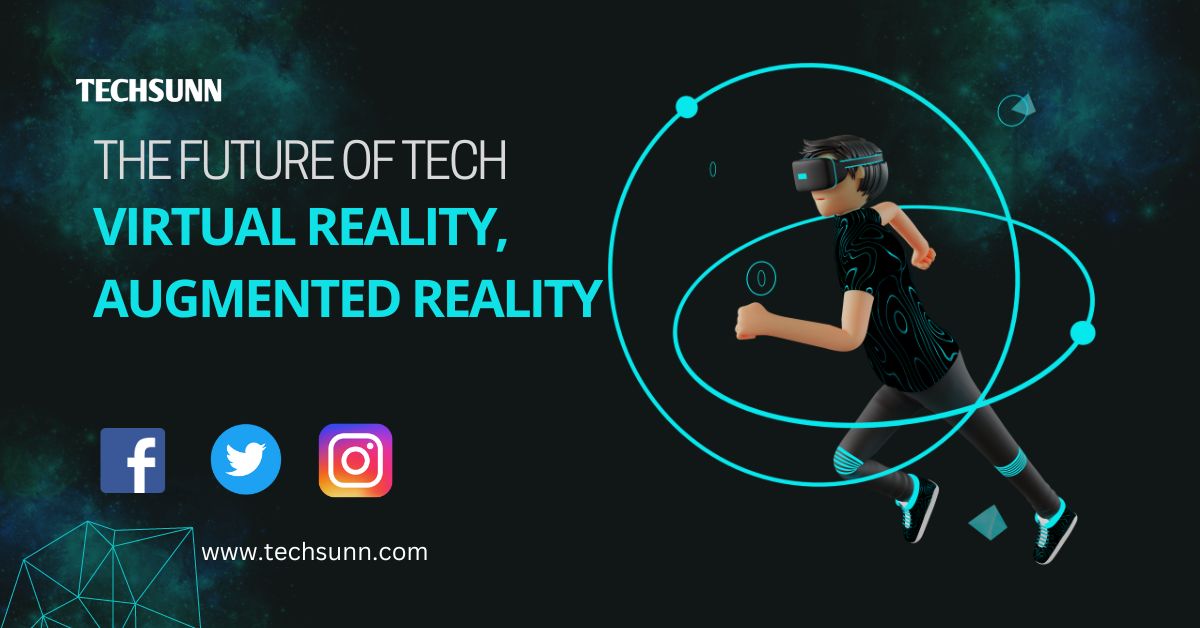Virtual Reality, Augmented Reality: The Future of Tech

Virtual Reality, Augmented Reality
Two of the most fascinating new technologies to emerge in recent years are virtual reality, augmented reality. Both technologies have the potential to change the way we interact with our surroundings.
A computer-generated simulation of a three-dimensional world that a person may explore is referred to as virtual reality. VR headsets are used to simulate being immersed in a virtual environment. VR has several uses, including gaming, education, training, and entertainment.
Virtual Reality, Augmented Reality: Benefits
Augmented reality is a technology that overlays a computer-generated picture on top of a user’s vision of reality. The augmented visuals are shown via AR headsets and smartphones. AR has several uses, including gaming, education, training, and marketing.
Here are some of the benefits of using VR and AR:
- Immersion: VR and AR can provide users with a sense of immersion that is not possible with traditional media. This can make learning and training more effective and engaging.
- Interactivity: VR and AR allow users to interact with the virtual world in a way that is not possible with traditional media. This can make games more immersive and educational experiences more engaging.
- Personalization: VR and AR can be personalized to the user’s individual needs and preferences. This can make learning and training more effective and enjoyable.

Here are some of the potential applications of VR and AR:
- Gaming: VR and AR are already being used in gaming. Some of the most popular VR games include Beat Saber, Superhot VR, and Half-Life: Alyx. AR games are also becoming popular, with titles like Pokémon Go and The Walking Dead: Our World leading the way.
- Education: VR and AR can be used to create immersive and interactive learning experiences. For example, students can use VR to explore historical sites or to learn about different parts of the world. AR can be used to provide students with additional information about the objects they are studying.
- Training: VR and AR can be used to create realistic and immersive training simulations. This can be used to train employees for dangerous or difficult tasks, such as flying an airplane or performing surgery. AR can be used to provide real-time information and feedback to trainees.
- Marketing: VR and AR can be used to create immersive and interactive marketing experiences. For example, brands can use VR to let consumers try out new products or to take them on a virtual tour of a new store. AR can be used to provide consumers with additional information about products or to let them interact with brands in new ways.
Read Also: Revolutionizing Technology: Innovations and Future Trends
How does VR work?
Virtual reality (VR) works by simulating an environment in which the user may interact. This is accomplished via the use of a headset that projects the simulated world onto a screen in front of the user’s eyes. In addition, the headgear detects the user’s head motions, allowing the simulated world to be updated in real time.
How does AR work?
Augmented reality (AR) works by superimposing a computer-generated picture on top of a user’s real-world perspective. This is accomplished by wearing a headset or using a smartphone to show the computer-generated picture on a transparent screen. The headgear or smartphone also records the user’s head motions, allowing the computer-generated picture to be superimposed in real time over the actual environment.
What are the different types of VR and AR headsets?
There are two kinds of virtual reality headsets: tethered and solo. Tethered headsets are linked to a computer or game console, while standalone headsets are self-contained and do not need a separate device connection.
There are also two types of AR headsets: smart glasses and head-mounted displays (HMDs). Smart glasses are small and light enough to be worn like conventional glasses, but HMDs are bigger and more immersive.
VR and AR have a promising future. Both technologies have the potential to alter our interactions with our environment. As technology progresses, we may see VR and AR used in a wider range of applications.
Here are some of the challenges of using VR and AR:
- Cost: VR and AR headsets can be expensive. This can make them inaccessible to some users.
- Hardware requirements: VR and AR headsets require powerful hardware to run. This can make them difficult to use on mobile devices.
- Motion sickness: Some users experience motion sickness when using VR and AR headsets. This can limit the use of these technologies for some people.
- Privacy and security: VR and AR headsets collect a lot of data about users, which raises privacy and security concerns.
- Addiction: VR and AR can be addictive, which can lead to problems such as social isolation and decreased productivity.
Despite these obstacles, virtual reality and augmented reality (AR) are two of the most fascinating new technologies to emerge in recent years. Both technologies have the potential to change the way we interact with our surroundings.
Conclusion
To summarize, virtual reality and augmented reality are two of the most fascinating new technologies to emerge in recent years. Both technologies have the potential to change the way we interact with our surroundings.
Although virtual reality and augmented reality are still in their early phases of development, they have already been used in a variety of applications such as gaming, education, training, marketing, and healthcare. As technology advances, we may expect to see VR and AR applied in a broader variety of applications.
Before VR and AR to become popular technology, a lot of difficulties must be overcome. Cost, hardware requirements, motion sickness, privacy and security, and addiction are among the obstacles. However, the potential advantages of VR and AR are considerable, and these problems are expected to be solved in the coming years.
VR and AR have the potential to revolutionize how we live and work. They can improve the effectiveness and engagement of learning and training, making games more immersive and educational experiences more engaging, and make marketing more interactive and engaging. As technology advances, we can anticipate VR and AR to become an increasingly vital part of our daily lives.



